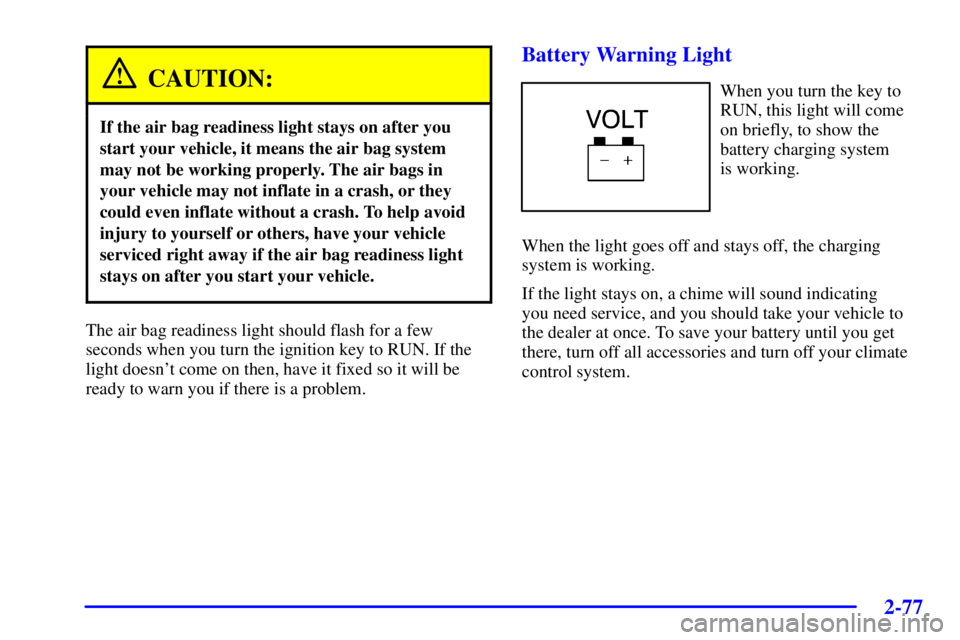BUICK PARK AVENUE 2002 Owner's Manual
Manufacturer: BUICK, Model Year: 2002, Model line: PARK AVENUE, Model: BUICK PARK AVENUE 2002Pages: 395, PDF Size: 2.67 MB
Page 131 of 395

2-68
3. When the HomeLink indicator light begins to blink
slowly (this may take up to 30 seconds), hold the
hand
-held transmitter about 1 to 3 inches (3 to 8 cm)
from HomeLink and then press and hold the transmit
button on the hand
-held transmitter. Continue to
hold both buttons until the indicator light on
HomeLink begins to flash rapidly (this may take
up to 90 seconds).
If you have trouble programming HomeLink, make
sure that you have followed the directions exactly as
described and that the battery in the hand
-held
transmitter is not weak. If you still cannot program it,
move the hand
-held transmitter to the left or right or
forward or backward or flip it upside down. HomeLink
may not work with older garage door openers that do
not meet current Federal Consumer Safety Standards.
If you cannot program the transmitter after repeated
attempts, refer to ªTraining a Garage Door Opener with
Rolling Codesº later in this section or contact the
manufacturer of HomeLink at 1
-800-355-3515, or on
the internet at www.homelink.com.
Be sure to keep the original hand
-held transmitter in
case you need to erase and reprogram HomeLink.
Training a Garage Opener with aªRolling
Codeº Feature (If Equipped)
If you have not previously programmed the hand-held
transmitter to HomeLink, see ªProgramming the
HomeLink Transmitterº listed previously. If you have
completed this programming already, you now need to
train the garage door opener motor head unit to
recognize HomeLink.
1. Find the ªLearnº or ªSmartº button on the
garage door opener motor head unit. The exact
location and color will vary by garage door opener
brand. If you have difficulty finding the Learn or
Smart button, refer to your garage door opener
owner's manual or contact the manufacturer of
HomeLink at 1
-800-355-3515, or on the
internet at www.homelink.com.
Because of the steps involved, it may be helpful
to have another person assist in programming
the transmitter.
Page 132 of 395

2-69
2. Press the Learn or Smart button on the garage
door opener motor head unit. An indicator light will
begin to flash when the motor head unit enters the
training mode.
Following this step, you have 30 seconds to
start Step 3.
3. Return to HomeLink in your vehicle and firmly
press and release the programmed HomeLink
button three times.
The rolling
-code garage door opener should now
recognize HomeLink. You may either use HomeLink or
the hand
-held transmitter to open the garage door.
If after following these instructions, you still have
problems training the garage door opener, contact the
manufacturer of HomeLink at 1
-800-355-3515, or on
the internet at www.homelink.com.
Canadian Programming
Canadian Owners: During programming, the
hand
-held transmitter may automatically stop
transmitting after two seconds. In this case, you should
press and hold the HomeLink button (see Steps 2 and 3
under ªProgramming the HomeLink Transmitterº) while
you press and repress (cycle) your hand
-held transmitter
every two seconds until HomeLink is trained.
Operating the HomeLink Transmitter
Press and hold the appropriate button on HomeLink for
at least a half of a second. The indicator light will come
on while the signal is being transmitted.
Erasing Channels
To erase all three programmed channels, hold down the
two outside buttons on HomeLink until the indicator
light begins to flash (approximately 20 seconds).
Release both buttons.
Resetting Defaults
To reset HomeLink to default settings, hold down the
two outside buttons on HomeLink until the indicator
light begins to flash (approximately 20 seconds).
Continue to hold the buttons until the HomeLink
indicator light turns off and then release both buttons.
Accessories
Accessories for HomeLink are available. If you would
like additional information, please contact the
manufacturer of HomeLink at 1
-800-355-3515,
or on the internet at www.homelink.com.
Page 133 of 395

2-70
The Instrument Panel -- Your Information System
Page 134 of 395

2-71
The main components of your instrument panel are the following:
A. Air Outlet
B. Exterior Lamps Control
C. Turn Signal/Multifunction Lever
D. Steering Wheel Controls
E. Hazard Warning Flashers Button
F. Instrument Panel Cluster
G. Shift Lever
H. Audio System
I. Air Outlet
J. Fuel Door Release ButtonK. Trunk Release and Lockout Button
L. Hood Release
M. Ignition Switch
N. Traction Control Button (If Equipped)
O. Heated Seat Controls (Option)
P. Ashtray and Cigarette Lighter
Q. Climate Control System
R. Glove Box
S. Passenger Climate Control
Page 135 of 395

2-72
Instrument Panel Clusters
Your vehicle is equipped with one of the following instrument panel clusters. Your instrument panel cluster is designed
to let you know at a glance how your vehicle is running. It includes indicator warning lights and gages that are
explained on the following pages. Be sure to read about those that apply to the instrument panel cluster for your vehicle.
Standard Cluster (United States version shown, Canada similar)
Page 136 of 395

2-73
Cluster with Driver Information Center (DIC) (United States version shown, Canada similar)
Page 137 of 395

2-74
Speedometer and Odometer
Your speedometer lets you see your speed in both miles
per hour (mph) and kilometers per hour (km/h). Your
odometer shows how far your vehicle has been driven,
in either miles (used in the United States) or kilometers
(used in Canada).
Your vehicle has a tamper
-resistant odometer. You may
wonder what happens if your vehicle needs a new
odometer installed. If possible, the new one has to be set
to the same reading the old one had. If it can't be, then
it's set at zero and a label must be put on the driver's
door to show the old mileage reading and when the new
odometer was installed.
Trip Odometer
A trip odometer can tell how far you've driven since
you last set it back to zero. To reset it, push the RESET
button. The trip odometer is reset through the Driver
Information Center (DIC) if your vehicle is equipped
with this feature.
Tachometer
The tachometer tells you
how fast the engine is
running. It displays
engine speed in thousands
of revolutions per
minute (rpm).
NOTICE:
Do not operate the engine with the tachometer in
the shaded area, or engine damage may occur.
Page 138 of 395

2-75
Warning Lights, Gages
and Indicators
This part describes the warning lights and gages that
may be on your vehicle. The pictures will help you
locate them.
Warning lights and gages can signal that something is
wrong before it becomes serious enough to cause an
expensive repair or replacement. Paying attention to
your warning lights and gages could also save you or
others from injury.
Warning lights come on when there may be or is a
problem with one of your vehicle's functions. As you
will see in the details on the next few pages, some
warning lights come on briefly when you start the
engine just to let you know they're working. If you
are familiar with this section, you should not be alarmed
when this happens.Gages can indicate when there may be or is a problem
with one of your vehicle's functions. Often gages and
warning lights work together to let you know when
there's a problem with your vehicle.
When one of the warning lights comes on and stays on
when you are driving, or when one of the gages shows
there may be a problem, check the section that tells you
what to do about it. Please follow this manual's advice.
Waiting to do repairs can be costly
-- and even
dangerous. So please get to know your warning lights
and gages. They're a big help.
Your vehicle may also have a Driver Information Center
(DIC) that works along with the warning lights and
gages. See ªDriver Information Centerº in the Index.
Page 139 of 395

2-76
Safety Belt Reminder Light
When the key is turned to RUN, a chime will come
on for about eight seconds to remind people to fasten
their safety belts, unless the driver's safety belt is
already buckled.
The safety belt light will
also come on and stay on
for about 20 seconds, then
it will flash for about
55 seconds.
If the driver's belt is already buckled, neither the chime
nor the light will come on.
Air Bag Readiness Light
There is an air bag readiness light on the instrument
panel, which shows AIR BAG. The system checks the
air bag's electrical system for malfunctions. The light
tells you if there is an electrical problem. The system
check includes the air bag sensors, the air bag modules,
the wiring and the crash sensing and diagnostic module.
For more information on the air bag system, see ªAir
Bagº in the Index.
This light will come on
when you start your vehicle,
and it will flash for a few
seconds. Then the light
should go out. This means
the system is ready.
If the air bag readiness light stays on after you start the
vehicle or comes on when you are driving, your air bag
system may not work properly. Have your vehicle
serviced right away.
Page 140 of 395

2-77
CAUTION:
If the air bag readiness light stays on after you
start your vehicle, it means the air bag system
may not be working properly. The air bags in
your vehicle may not inflate in a crash, or they
could even inflate without a crash. To help avoid
injury to yourself or others, have your vehicle
serviced right away if the air bag readiness light
stays on after you start your vehicle.
The air bag readiness light should flash for a few
seconds when you turn the ignition key to RUN. If the
light doesn't come on then, have it fixed so it will be
ready to warn you if there is a problem.
Battery Warning Light
When you turn the key to
RUN, this light will come
on briefly, to show the
battery charging system
is working.
When the light goes off and stays off, the charging
system is working.
If the light stays on, a chime will sound indicating
you need service, and you should take your vehicle to
the dealer at once. To save your battery until you get
there, turn off all accessories and turn off your climate
control system.